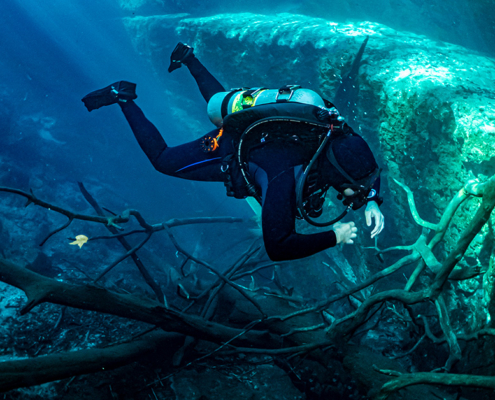6 Key Differences in Diving a Dry Suit vs a Wetsuit
by: Jim Lapenta SDI/TDI Instructor
Much of the advertising one sees for diving involves warm water and divers in swimsuits or thin wetsuits. It can be a bit of a shock to those divers who were certified in warm water to make a pilgrimage to a cold water location. For those of us who dive and teach in much of the northern hemisphere, talking about the differences is much like talking about how to choose a mask.
We are often asked about the differences between diving wet and diving dry. Other than the obvious answer – “you don’t need to dry anything but your hair after the dive” – there are some key differences.
1. Warmth.
This is probably the most important reason to decide to dive dry. You know that neither a wetsuit nor dry suit actually keeps you warm. What they do is slow the amount of heat loss. Wet suits do this using a layer of neoprene and a thin layer of water trapped between that and the skin. Dry suits use air and a combination of undergarments. No water to take heat away if a seal is lost and allowed to flush through the suit. With drysuits you can add layers of insulation to slow the loss of body heat.
2. Buoyancy.
Wetsuits compress with depth and lose some of their inherent buoyancy. Dry suits allow the diver to add air and compensate for the increased pressure at depth. As the wetsuit compresses, it gets thinner and loses insulating capacity. The dry suit does not.
3. Weighting.
Once a diver has become proficient with a dry suit, over-weighting is not as much of a concern as it is with a wetsuit. As a wetsuit loses buoyancy at depth, a diver can become seriously over weighted due to suit compression. With a dry suit, the amount of buoyancy the suit offers stays more or less constant since the diver has the means to adjust for the increased/decreased pressure.
4. Varying conditions.
A large benefit of a dry suit is the ability to use the suit in various conditions. A wetsuit does not offer the flexibility of a dry suit to add or subtract undergarments to suit the water/surface conditions. Many divers use their dry suit year round, from warm water locations to under the ice in winter.
5. Purchase cost.
At one time dry suits were prohibitively expensive for the average diver. One could purchase several wetsuits for the cost of one dry suit. They often had to if diving in a wide range of water temperatures! With the introduction of new materials and manufacturing competition, a quality entry level dry suit can be had for roughly the same price as a higher end wetsuit. By varying the undergarments the diver can also avoid having to buy several different thicknesses of wetsuits. One dry suit will work in numerous environments.
6. Cost of ownership.
Once a diver buys a wetsuit there is very little maintenance other than proper rinsing. Dry suits require seals to be replaced, leaks attended to, boots or socks replaced, and maybe even the zipper. These costs may be offset by the life of the suit. Dry suits, with proper care, can last 15 – 20 years or more. This is using the suit on a regular basis- say 100 dives a year. A wetsuit seeing that much use may last five years. In the long run, a drysuit may actually be less expensive. Dry suits often hold their value for resale. Used wetsuits get tossed. Used dry suits are sold to offset the cost of a new one!
For more on the differences/ benefits of dry suit diving, contact your SDI/TDI/ERDI Instructor to see if it’s a wise choice for you.











Wonderful blog post.